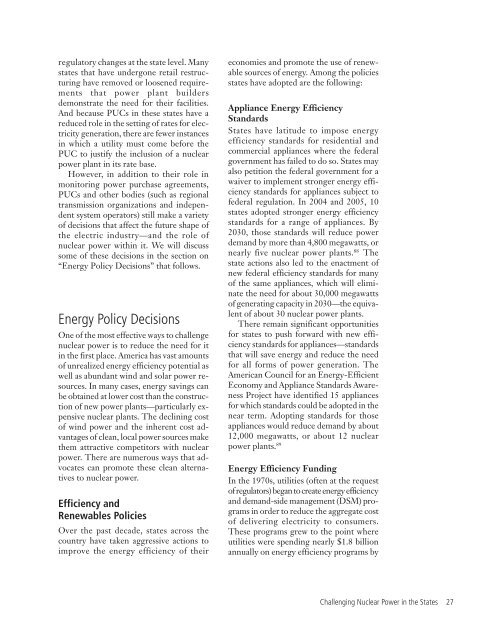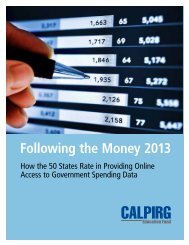Download Report (PDF) - CalPIRG
Download Report (PDF) - CalPIRG
Download Report (PDF) - CalPIRG
Create successful ePaper yourself
Turn your PDF publications into a flip-book with our unique Google optimized e-Paper software.
egulatory changes at the state level. Many<br />
states that have undergone retail restructuring<br />
have removed or loosened requirements<br />
that power plant builders<br />
demonstrate the need for their facilities.<br />
And because PUCs in these states have a<br />
reduced role in the setting of rates for electricity<br />
generation, there are fewer instances<br />
in which a utility must come before the<br />
PUC to justify the inclusion of a nuclear<br />
power plant in its rate base.<br />
However, in addition to their role in<br />
monitoring power purchase agreements,<br />
PUCs and other bodies (such as regional<br />
transmission organizations and independent<br />
system operators) still make a variety<br />
of decisions that affect the future shape of<br />
the electric industry—and the role of<br />
nuclear power within it. We will discuss<br />
some of these decisions in the section on<br />
“Energy Policy Decisions” that follows.<br />
Energy Policy Decisions<br />
One of the most effective ways to challenge<br />
nuclear power is to reduce the need for it<br />
in the first place. America has vast amounts<br />
of unrealized energy efficiency potential as<br />
well as abundant wind and solar power resources.<br />
In many cases, energy savings can<br />
be obtained at lower cost than the construction<br />
of new power plants—particularly expensive<br />
nuclear plants. The declining cost<br />
of wind power and the inherent cost advantages<br />
of clean, local power sources make<br />
them attractive competitors with nuclear<br />
power. There are numerous ways that advocates<br />
can promote these clean alternatives<br />
to nuclear power.<br />
Efficiency and<br />
Renewables Policies<br />
Over the past decade, states across the<br />
country have taken aggressive actions to<br />
improve the energy efficiency of their<br />
economies and promote the use of renewable<br />
sources of energy. Among the policies<br />
states have adopted are the following:<br />
Appliance Energy Efficiency<br />
Standards<br />
States have latitude to impose energy<br />
efficiency standards for residential and<br />
commercial appliances where the federal<br />
government has failed to do so. States may<br />
also petition the federal government for a<br />
waiver to implement stronger energy efficiency<br />
standards for appliances subject to<br />
federal regulation. In 2004 and 2005, 10<br />
states adopted stronger energy efficiency<br />
standards for a range of appliances. By<br />
2030, those standards will reduce power<br />
demand by more than 4,800 megawatts, or<br />
nearly five nuclear power plants. 88 The<br />
state actions also led to the enactment of<br />
new federal efficiency standards for many<br />
of the same appliances, which will eliminate<br />
the need for about 30,000 megawatts<br />
of generating capacity in 2030—the equivalent<br />
of about 30 nuclear power plants.<br />
There remain significant opportunities<br />
for states to push forward with new efficiency<br />
standards for appliances—standards<br />
that will save energy and reduce the need<br />
for all forms of power generation. The<br />
American Council for an Energy-Efficient<br />
Economy and Appliance Standards Awareness<br />
Project have identified 15 appliances<br />
for which standards could be adopted in the<br />
near term. Adopting standards for those<br />
appliances would reduce demand by about<br />
12,000 megawatts, or about 12 nuclear<br />
power plants. 89<br />
Energy Efficiency Funding<br />
In the 1970s, utilities (often at the request<br />
of regulators) began to create energy efficiency<br />
and demand-side management (DSM) programs<br />
in order to reduce the aggregate cost<br />
of delivering electricity to consumers.<br />
These programs grew to the point where<br />
utilities were spending nearly $1.8 billion<br />
annually on energy efficiency programs by<br />
Challenging Nuclear Power in the States 27




